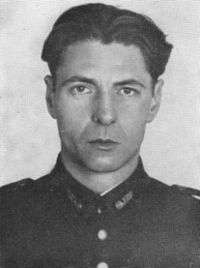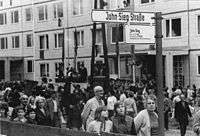John Sieg

John Sieg (February 3, 1903 – October 15, 1942) was a railroad worker and journalist who publicized Nazi atrocities through the underground Communist press and fought against National Socialism in the German Resistance. He was a key member of the Red Orchestra.
Biography
John Sieg was born in Detroit, Michigan, the son of a mechanic. After the death of his father in 1912, he lived with his grandfather in Germany and became a German citizen in 1920.[1]
In the beginning of the 1920s, Sieg went to school to become a teacher, but when his grandfather died in 1923, he had to quit. He returned to the Detroit and met his future wife, Sophie, in 1924, while working as a college intern. He stayed in the United States until February 1928, when Sieg and his wife returned to Germany and he became a freelance author in Berlin.[1]
_1983%2C_MiNr_Block_070.jpg)
He began writing articles for Die Tat, a newspaper published by Adam Kuckhoff. After joining the Communist Party of Germany that same year, he began to write for the arts section of the KPD newspaper, Die Rote Fahne and he got to know Wilhelm Guddorf and Martin Weise.
He was arrested by the Sturmabteilung (storm troopers) in March 1933 and held till June. Upon his release, he began working with the Communist Resistance in the Berlin suburb of Neukölln, becoming the focal point of several groups. He had close contact with Arvid Harnack and Kuckhoff. He took part in leafletting campaigns and shared political information. In 1937, he got a job with the Deutsche Reichsbahn, eventually working as a signaller at the S-Bahn station at Papestraße. As a railroad employee, Sieg was able to make use of work-related travel and free travel to build connections with other Resistance groups, such as the one organized around Bernhard Bästlein.[1]
He worked with Herbert Grasse, Otto Grabowski and the Saefkow-Jacob-Bästlein Organization to produce the newspaper, Die Innere Front (The Internal Front).[1] He was a core member of the Rote Kapelle, along with Guddorf and Kuckhoff.
He was arrested on October 11, 1942 and was taken to the Gestapo prison on Prinz-Albrecht-Straße, where he endured intensive interrogations and abuse. The previous spring, he had confided to a friend that if he were ever arrested, he would commit suicide rather than risk betraying friends. On October 15, 1942, following severe mistreatment, he hanged himself in his cell.[1]
Sieg's wife, Sophie was also arrested in October 1942 and without a courtroom procedure, was sent to Ravensbrück concentration camp in 1943. She was liberated by the Red Army in 1945.[2]
Legacy

A street in an area of new construction on Frankfurter Allee-Süd in Berlin-Lichtenberg was named after John Sieg on June 22, 1972.[3]
See also
Further reading
- Hans Coppi, Jr., Jürgen Danyel and Johannes Tuchel. Die Rote Kapelle im Widerstand gegen den Nationalsozialismus. Hentric, Berlin 1994, ISBN 3-89468-110-1 (German)
- Alfred Gottwaldt. Innere Front. Erinnerungen an John Sieg, Reichsbahngehilfe und Widerstandskämpfer. In: Eisenbahn Geschichte, No. 26 (February–March 2008) pp. 57–59 (German)
- Regina Griebel, Marlies Coburger, Heinrich Scheel. Erfasst? Das Gestapo-Album zur Roten Kapelle. Audioscop, Halle/S. 1992, ISBN 3-88384-044-0 (German)
- Gert Rosiejka. Die Rote Kapelle. „Landesverrat“ als antifaschistischer Widerstand. ergebnisse, Hamburg 1986, ISBN 3-925622-16-0 (German)
- Helmut Schmidt (Ed.) John Sieg. Einer von Millionen spricht. Dietz Verlag Berlin 1989, ISBN 3-320-01392-0 (German)
External links
- Museum Lichterberg, Berlin Retrieved April 7, 2010 (German)
References
- 1 2 3 4 5 "NS-Widerstandskämpfer/Innen" (click on name) Museum Lichterberg, official website. List of German Resistance fighters. Retrieved April 7, 2010 (German)
- ↑ Vereinigung der Verfolgten des Naziregimes - Bund der Antifaschisten Köpenick Photo of Sophie and John Sieg, plus brief details about Sophie Sieg. Retrieved April 7, 2010 (German)
- ↑ Map link to John-Sieg-Straße, 10365 Berlin, Germany Google Maps. Retrieved April 7, 2010